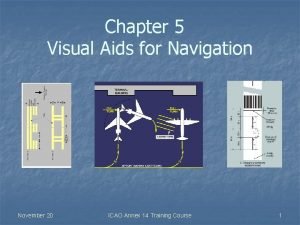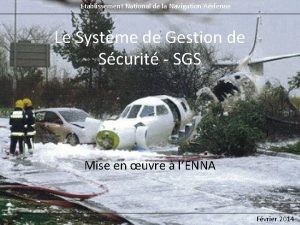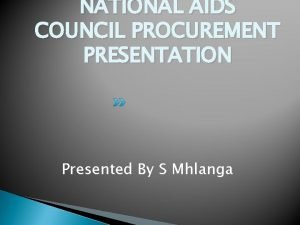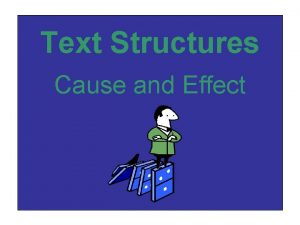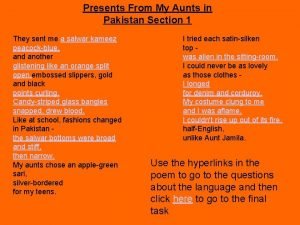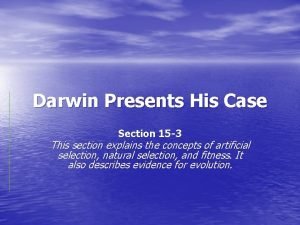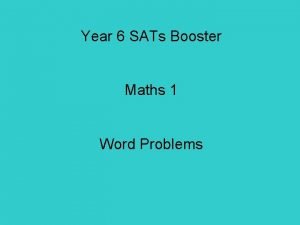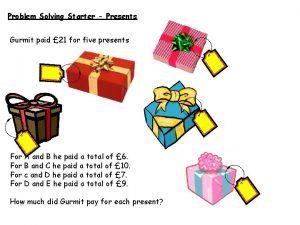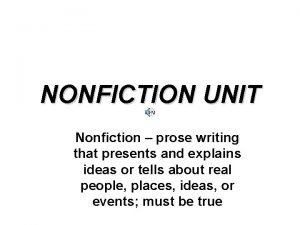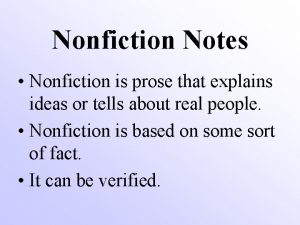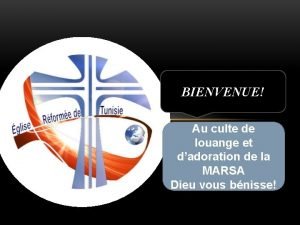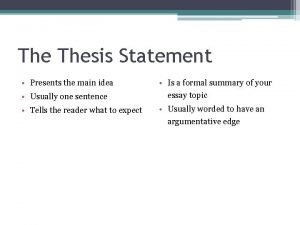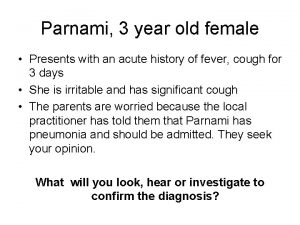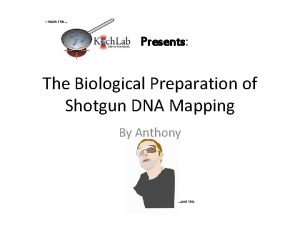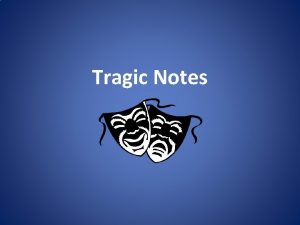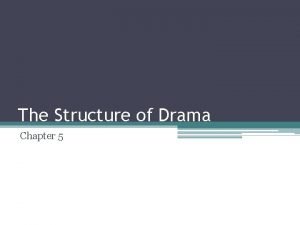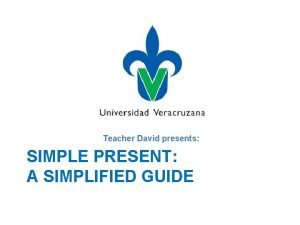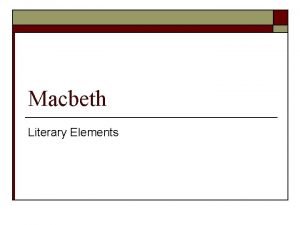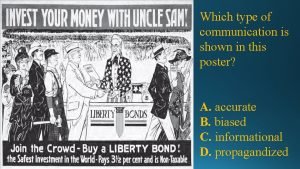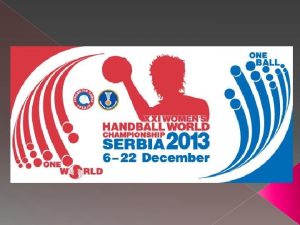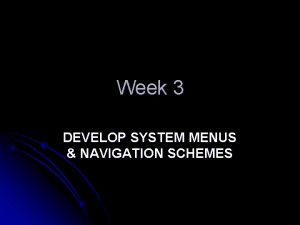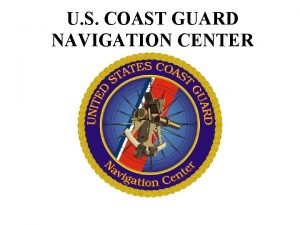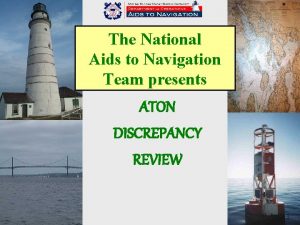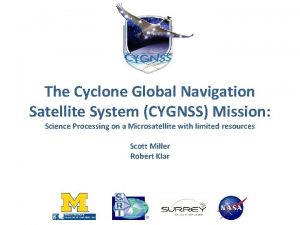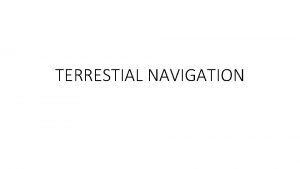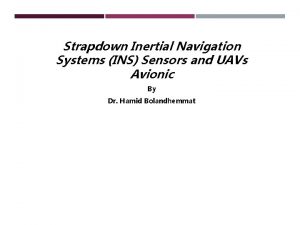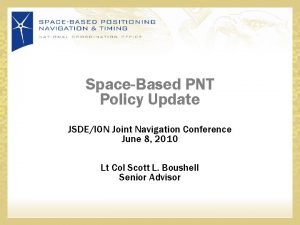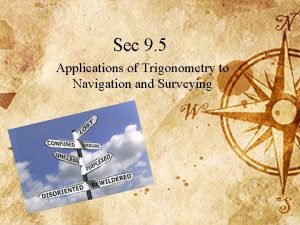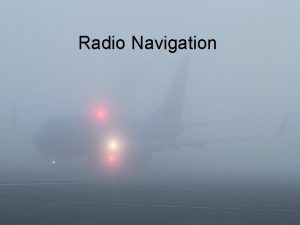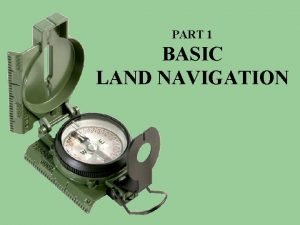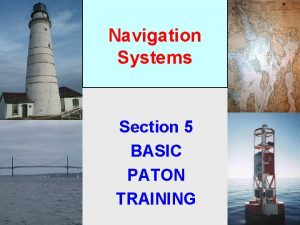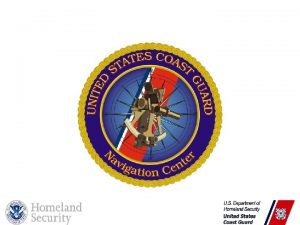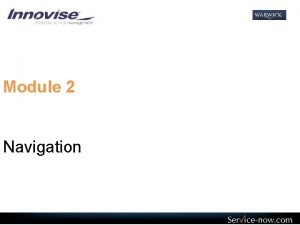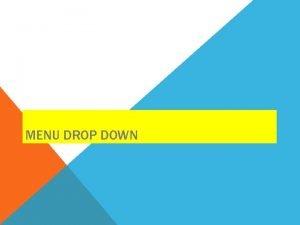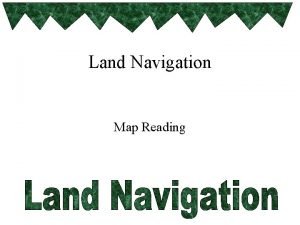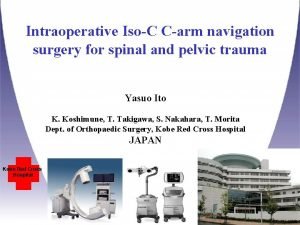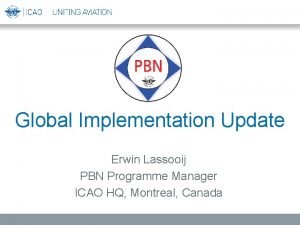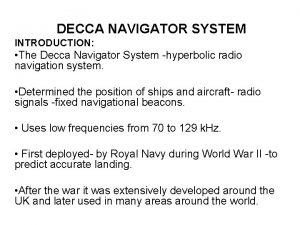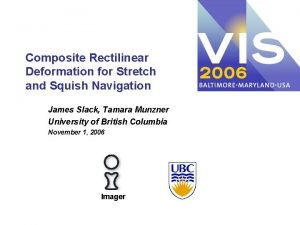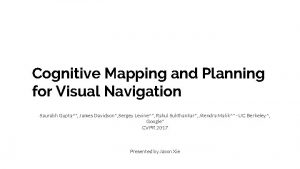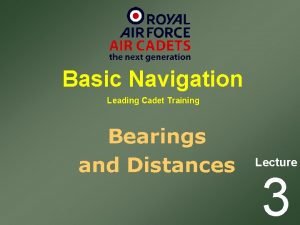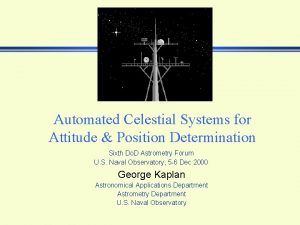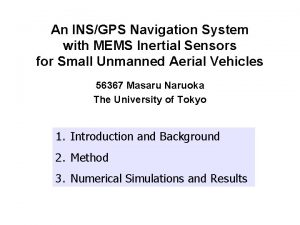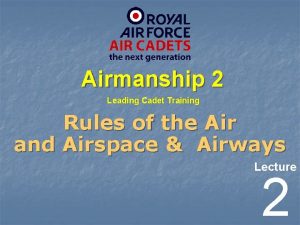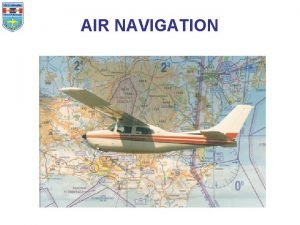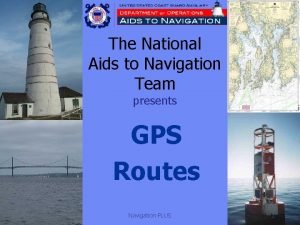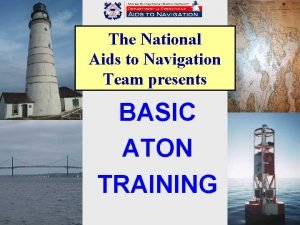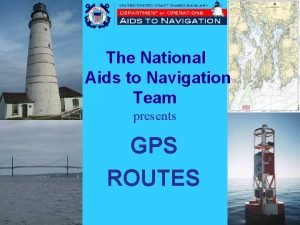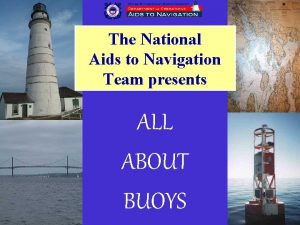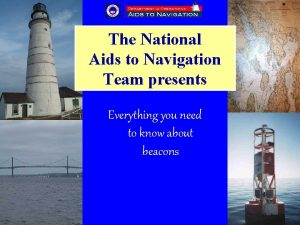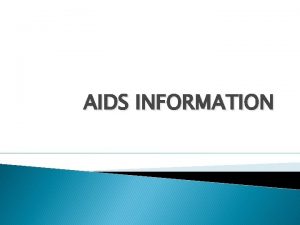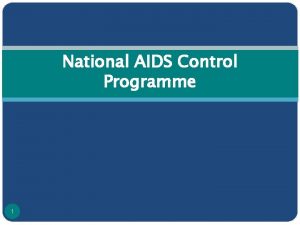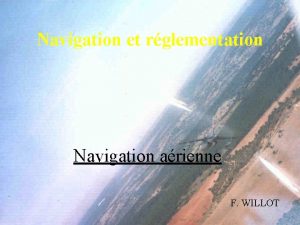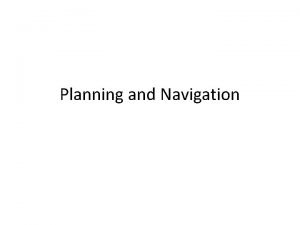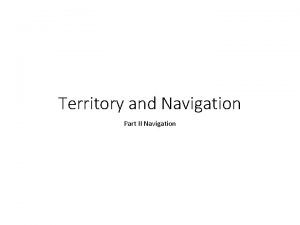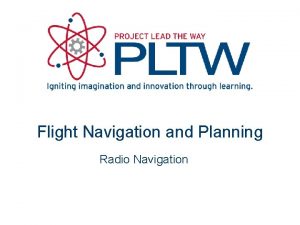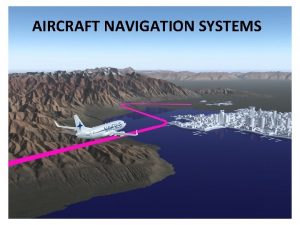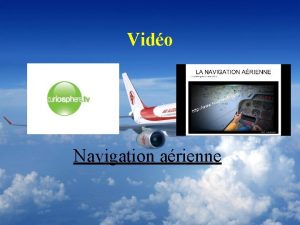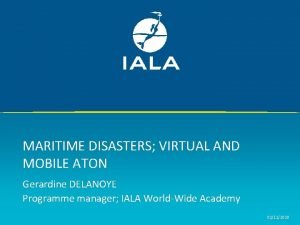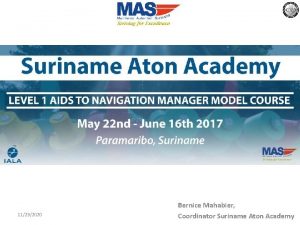The National Aids to Navigation Team presents ATON

















































































































- Slides: 113

The National Aids to Navigation Team presents ATON DISCREPANCY REVIEW 1

Presentation Objectives n To acquire a general knowledge of the responsibilities of the Auxiliary for performing discrepancies and verification checks. n To review the three categories of ATON discrepancies. n To help you recognize a discrepancy on an aid to navigation. 2

Discrepancy Categories Critical Urgent Routine 3

Definition of Critical This term is used for those discrepancies where failure to report by the most expeditious means may result in loss of life or damage to a vessel. 4

Critical Discrepancies a. Aid totally covered or shrouded in ice. b. Light signal showing improper characteristics or rhythm. c. Light signal obscured or extinguished. d. Sinking or submerged buoy. e. Buoy off station, adrift, missing, capsized or stranded. f. Radio beacon off the air or giving improper characteristics. g. Vandalism of aids. h. Aids damaged by vessel collision. i. Collapsed bridge structures. j. RACON not operating. k. Lantern damaged If a Federal Aid or a PATON is listed in the Light List (Class II), report at once to the C. G. ANT by the most expeditious means. 5

Definition of Urgent This term is used for those discrepancies where failure to report will result in no danger of loss of life or vessel damage, but may contribute to a grounding or a stranding. 6

Urgent Discrepancies Ifa. a. Daymark(s) Federal Aid or a PATON missing e. Lights partly or or damaged byin the Light is listed List totally obscured by causes other than dayboards. vandalism. (Class II), reportf. at once to Bridge light b. Sound signal failure. outages. the C. G. Horn, ANT most Bell, Gong, etc. by the g. Inoperative draw c. Radio beacon timing expeditious means. on swing, lift or sequence incorrect. d. Light burning dim or showing reduced intensity. retractable bridges. 7

Definition of Routine Term is used for those discrepancies where failure to report will result in very low likelihood of grounding or stranding, but corrective maintenance is necessary. 8

Routine Discrepancies a. Aid obscured by foliage or other objects that need to be removed. b. Faded daymarks, located on floating aids or fixed on a shore site. c. Extensive bird fowling obscure the purpose of aid. d. Delaminating of dayboards. e. Dayboards missing. f. Improper dayboards per reference to the Light List. g. Extensive deterioration or rotting of supports. h. Aid structures leaning more than 15 degrees. And there’s more. . . 9

Routine Discrepancies i. j. k. Vent valve is missing. A bird nest on the aid is obstructing the light or panels. Retroreflective material is peeling, missing or not adequate. l. Numbers on aid are obliterated or not easily read or identified. m. Peeling paint is interfering with the ability to see the aid or recognize its proper color. n. Whistle, tapper, or bell is missing. Forward to the C. G. UNIT through your Auxiliary Unit Coordinator by mail. 10

A I D D E F E C T S 11

Lantern Guard Ring Radar Reflectors Tower Braces Battery Pockets Buoy Top Head Tower Legs Lifting Padeye Buoy Body Bottom Head Gussets Buoy Tube Counterweight Seat Mooring Padeye Chafe Block Counterweight

M O R E I S S U E S 13

14

Battery Pockets n Battery Pockets: Hollow watertight tubes built into the buoy body that hold the batteries. Not a concern when the new LED light fixtures are used.

The reason for the venting system on Lighted Buoys n The batteries used in lighted buoys require a continuous means of airflow. n Primary batteries require oxygen from the air to operate. n While secondary (solar) batteries must vent flammable hydrogen gasses.

Vent System Vent Valve Vent Line Cross Over Tube

Vent Valve Designed to seal when the buoy heels over 30 degrees or is submerged. Reducer Valve Body Upper Valve Ball Lower Valve Ball

Battery Box n n n There are single and double battery boxes. A vent valve must be installed. Box may be painted the color of the buoy.

Sound Systems There are three main types of wave actuated sound signals: Whistle Bell Gong

Whistle is made of cast bronze and is mounted inside the cage. n As air is forced through the whistle, the familiar drone sound is made. n

BELLS Bells used on lighted and unlighted buoys and are made of a copper-silicon alloy. n External tappers impact the fixed bell when wave motion causes the buoy to roll. n

1975 Type Tapper n This type tapper is a modification of the 1962 type. The tapper balls come in various sizes and have been designed to minimize vibration. (Standard)

LED LANTERN (Light Emitting Diode) 24

Introduction MFG by Carmanah of Canada. n Approved as a replacement for the 155 mm. n Used with a 5 NFR/5 CFR to replace old style TRLB. n Cost $749. 00. n Programmable flash rhythm (TV remote). n 25

Model 701 n n Self-powered. Omni-directional. Single Unit-Solar panels, flasher, battery, DLC and lantern housed together. 3 mile range. 26

Model 701 n n n Available in RED, GREEN, YELLOW, and WHITE. Programmable flash characteristic. FIXED characteristic has 2 mile range. 27

Model 702 n n Larger battery. More Solar Panels. Designed for use in limited sunlight. Same features as 701. 28

Model 702 -5 n n n Same as 702. Extra solar panel on top. Designed for extremely limited sunlight (less than 1. 5 hrs a day). 29

Model 601 n n n Not approved for use by USCG. 2 NM range. Self-contained. May be used on private aids. Small, lightweight, easy to install, inexpensive. 30

Charging (700 series) Charged prior to shipment. n MUST be recharged if not installed within 2 months of receipt. n Charge by placing in direct sunlight for 60 hours. n 60 hours does not include nighttime. n 31

Charging With External Charger Cell Phone type charger available from mfg. n Open Lantern, disconnect battery and SP. n Measure battery voltage. n Plug charger into battery and charge in accordance with battery voltage. n DO NOT OVERCHARGE. n 32

Charging (con’t) n n 701 Lantern (15 ahs) 4. 14 volts- 5 hours 3. 98 -4. 14 volts- 15 hrs 3. 86 or less- 20 hrs n n 702 & 702 -5 ( 24 ahs) 7 hours 18 hours 27 hours 33

Programming n n Lantern color determined by colored dot near serial number. Any flash characteristic can be programmed using a Universal TV remote control. Security code must be entered to prevent accidentally changing characteristic. Follow instructions supplied with lantern. 34

Installation Install with three bolts similar to a 155. n Use leveling bolts on a structure. n Bolts can obstruct solar panels, make sure they protrude only as much as necessary. n Install nylon insulating spacer on buoys to minimize corrosion. n 35

Service Life LED lanterns do not burn out. n Light output degrades over time. n Replace lanterns according to Duty Cycle. n 10 -29% duty cycle replace every 12 yrs. n 30 -100% replace every 8 years. n Replace battery every 4 years. n 36

Servicing Service according to standard interval cycle established for the aid. n Clean lens with mild soap and water. n Cover lantern with shroud and time flash characteristic. n Observe LEDs through lens. n Replace optic if Dark Sectors are observed. n 37

Coast Guard servicing an Aid 38

39

Maneuvering into position near the aid. 40

Pulling the buoy. 41

Placing the buoy on deck. 42

Servicing the harness. ? 43

Inspecting the chain and anchor 44

Servicing the lantern. 45

Faking out the chain in preparation to resetting the buoy.

Aid is put back on station 47

Small Lights and Daymarks 48

Don’t get too close to this ATON! Stay in the channel. 49

Check after storms. Panels are designed to break away so that high winds or waves will not destroy the support pile. 50

Single Pile Structure n Used in protected or semi-exposed locations where fixity can be attained. 2

Multiple Pile Structures Used when fixity can not be achieved with single pile. n Two categories: n Dolphin Platform Structure

Dolphin n Battered pile Three to seven piles driven at an angle with the bottoms spread and the tops secured with wire rope or bolts and shear connectors. 13

Dolphin n Cluster n pile Three or more piles driven vertically with their surfaces in contact with each other and wrapped tightly at various heights.

#7, a small light, off Castle Island in Boston Harbor. 55

Lantern Platform Structure Battery Box n Three to or more separate Things Tower piles driven vertically, check on connected at the top by a this aid. platform that spreads the load over all the piles. Usually is. Platform the foundation for skeleton towers. Structure

Battery Box Large box is designed to hold up to 4 secondary batteries. n Small box is designed to hold up to 2 secondary batteries. n Single battery boxes are available commercially and are acceptable as long as they are white in color. n

n NE AN n Installed when the reflectivity of the structure doesn’t meet operational requirements. A standard radar set should detect it at 1. 5 to 2 NM when mounted 10 ft above the water. Must be properly oriented to the channel. CH n L Radar Reflectors

Dayboards n. A dayboard shall always be installed for maximum utility. n The dayboard should be the dominant component of the silhouette with the battery box hidden behind it.

On what side should you pass this mark?

It is a little easier to make the decision in the daylight!

Raising the dayboard makes it more obvious.

What’s wrong with this daymark? 2 2

Mounting Dayboards n Dayboards should be fastened so the dayboard becomes sacrificial in high winds. n Dayboards shall be fastened to meet or exceed a lifetime of 5 years. n The fasteners shall not pierce the retroreflective border or characters.

5 Mounting Dayboard may be installed approximately 5 degrees from vertical. WHY? o

n Whenever possible, dayboards shall be mounted on an angle to the channel. n The angle will vary to best suit the channel. n In a straight channel, about 30 degrees. l CHANNEL Mounting This makes the number easier to read when abeam of the aid. 30 o

Dayboards n Dayboards differ in size and shape depending on the marking system and their specific function. n Each dayboard has a designator composed of a number followed by a group of letters.

Dayboards n The first number indicates the width of the dayboard in feet. 3’ 4’

Dayboards l The next letter refers to the shape or purpose of the dayboard. S-Square T-Triangle M-Mid-Channel K-Range J-Junction N-No Lateral Significance 69

Dayboards l The second letter represents the key or background color. R- Red G- Green W- White B- Black 70

Dayboards Additional information is shown by letters placed after a dash (-) I - Intracoastal SY - yellow square TY - yellow triangle 71

Dayboards 4 JR-SY 4’ for channel (4)Aid has 4 foot base – (J)is used junction – (R)functions as a nun in main channel – (SY)is used as a “Dual Purpose” aid (can) on the ICW.

Detection Range n As a mariner approaches a dayboard from a distance it is first detected as an object apart from its surroundings. This is the detection range

Recognition Range n Upon coming closer to the dayboard, it can be recognized as an aid to navigation. This is the recognition range

Identification Range Finally the aid can be identified when the mariner is close enough to read the numbers and letters. This is the identification range

Nominal Range n The nominal range rating is used to classify dayboards. l 3 SG and 4 TR – nominal range 1 NM l 4 SG and 6 TR – nominal range 2 NM l 6 SG and 8 TR – nominal range 3 NM

Films Retroreflective tape Vinyl Film 77

Retroreflective material Commonly called Retro. l Two manufacturers: n Reflexite has a smooth appearance 3 M has a honeycomb appearance 3 M and Reflexite materials may be used together on the same aid.

Front Panel Symbol KWR Main panel is white. Center stripe is red. 79

K - range dayboards l Range boards are always twice as tall as they are wide. 2 W W 80

Dayboards l l The third letter indicates the color of stripe (range dayboards only). R- Fluorescent red G- Fluorescent green W- White B- Black 81

Dayboards 6 KR W -1 6’

Operational Requirements n Contrast Vegetation Background lights

Inspection and Maintenance n Dayboard surface and backing materials will deteriorate due to the effects of weathering by: wind, n rain, n freezing temperatures, and n sunlight. n 84

Inspection and Maintenance n Types of delamination are: n Cracking, n Peeling. and n Fading. 85

Backing Material n Delamination should not have progressed over more than 25 percent of the backing material. n Material should not be sufficiently warped to visibly detract from the signal. n Mounting points should not be softened or deteriorated to the degree that the board may come loose during a storm. 86

Films, Numbers, Letters, and Borders. n Delamination of the film should not progress over 10% of the surface area. n Material should not be cracked, checked or abraded so as to provide a dull or roughened top surface. n Attached material should not have peeled more than 10% of the surface area. 87

Fading. . . n There is no practical way to measure fading. n Replacement is based on the judgment of servicing personnel. n Aid must be able to display the intended signal until its next scheduled service date.

. . . more FADING 1 3 NEW FADED 5 REPLACE 89

A Major Light “Boston Light” 90

All light houses are now unmanned, except for Boston Light —the oldest, continuous operating lighthouse in America. Check each lighthouse for properation. n Refer to your chart or Light List for the proper characteristics. n 91

Do you have any questions about ATON discrepancies? 92

HOW to make ROUTINE and follow up reports to the Coast Guard Unit. “ANSC 7054 Aid to Navigation Form” available on the “National Forms Web Site” 93

ANSC 7054 Aid to Navigation Form Has four sections: n Section I - Member’s Information. n Section II - Coast Guard Notification. Section III – Aid Owner, Identification, and Characteristics. n Section IV – Discrepancies. n 94

ANSC 7054 Aid to Navigation Form Section I – Members Information. Fill out your personal data on the ANSC 7054 Aid to Navigation Form that was handed out. It should only take a minute. 95

ANSC 7054 - Aid to Navigation Form Section II - Coast Guard Notification Only used for Critical or Urgent discrepancy reporting when you have already communicated with a C. G Unit or other C. G. agency. Indicate the means used. This section is never used for Routine discrepancy reports. 96

ANSC 7054 - Aid to Navigation Form Section II - Coast Guard Notification This is a critical report. ANT Bristol was phoned with the report on Aug. 8 from the OPFAC. Fill out the C. G. Notification data on the ANSC 7054 Aid to Navigation Form that was handed out. It should only take a minute. 97

ANSC 7054 - Aid to Navigation Form Section III – Aid Owner, Identification, and Characteristics. Enter the Aid Name and LLNR. Show the Chart Number. Enter the Latitude and Longitude. LAT = dd-mm-ss. ss N LON = ddd-mm-ss. ss W Enter the Depth alongside the aid. (Other) Correct for: Position of transducer. Height of Tide. Compare to charted depth at the aid. 98

ANSC 7054 - Aid to Navigation Form Observed depth = 23 feet Position of transducer = 2 feet Height of Tide = 3. 8 feet. FORMULA Observed Depth plus Position of transducer minus Height of Tide equals Corrected Depth 23 + 2 – 3. 8 = 21. 2 feet The charted depth is 21 feet 99

ANSC 7054 - Aid to Navigation Form Section III – Aid Owner, Identification, and Characteristics. This is the Channel Buoy #5 in Dorchester Bay, LLNR 23455, a lighted buoy, flashing every six seconds. It was observed at 23 -34 -56. 500 N / 07034 -44. 786 W. Depth was observed at 23 feet. The transducer is 2 feet below the water and the Height of Tide is 3. 8 feet at 1945. Fill out the Section III data on the ANSC 7054 Aid to Navigation Form that was handed out. 100

ANSC 7054 - Aid to Navigation Form Section III – Aid Owner, Identification, and Characteristics - continued Select the Ownership of the aid. Coast Guard, State, Private, other. Select the Type of Aid. Buoy, Structure, Lighted, Sound, Electronic, Single pile marker, Mile marker. If aid is a Structure, select: Wood, Metal, Other. If the aid has a Sound Signal, select: Bell, Gong, Horn, Whistle. If aid is lighted, indicate the Light Color: Red, Green, White, Yellow Complete Section III on the ANSC 7054 ATON form. 101

ANSC 7054 - Aid to Navigation Form Section IV – Discrepancies. The Channel Buoy #5 in Dorchester Bay, was observed as extinguished and the lantern was damaged. Fill out the Section IV data on the ANSC 7054 Aid to Navigation Form that was handed out. Enter any comments you think may be appropriate. 102

How does the Aid look? Does the observed aid comply with the IALA-B Aids to Navigation System? If not, explain in the comments section. 103

How does the Aid look? Does the observed aid match the entry for this aid in the Light List? If not, explain in the comments section. 104

How does the Aid look? Does the observed aid match the abbreviations and symbols for this aid on the Nautical Chart? If not, explain in the comments section. May also be a Chart Update Report. 105

Discrepancy reports may be reflected in the LNM - Local Notice to Mariners The Local Notice to Mariner is generated using the ATONIS Database • Chart Corrections • Discrepancies • Light List Changes 106

What is meant by the term “verification” of an aid? A verification anobserved aid means Furthermore, you of have that When the aid is private, it is assumed A lot ofyou knowledge, integrity, the aid conforms to the IALA-B Aid that have applied all of that you have confirmed that the aid to Navigation System. credibility andknowledge trainingasis your acquired of conforms to the specifications discrepancies on aids to assumed and expected when listed on the aid’s “Private Aid And, you have checked that your navigation tothe your observation Verification Form, ” provided fromthe observations of aid matches you use of the term “Watching ATONIS. of the and aid, abbreviations and did as not find symbols Properly” on you a verification printed for any the aid on the latest problem(s). report for a (P)ATON. nautical chart and as published in the Light List. 107

What is meant by the term “verification” of an aid? You took fix of alongside the You took aa depth alongside the aid. A verification an aid means You checked the observed aid using a have GPS with DGPS that you applied all of You corrected the depth for: LAT/LON to the aid’s assigned your acquired knowledge or WAAS and of reviewed theof The location the transducer. position. discrepancies on aids to EPEThe or. Height HDOP. You also of Tide. is available in the “Assigned position” navigation to+ Transducer your observation confirmed that the GPScorr. was “Observed depth –the Height List. If not listed, take of the aid, and you did not find of Tide = Estimated Depth corrected to datum” reading 4 orfrom more LAT/LON the satellites— nautical chart. any problem(s). checked the Estimated Depth to the 3 D You Operation. Charted Depth. 108

AND YOU DIDN’T FIND ANY PROBLEMS! 109

DO NOT REPORT the verification of a Federal aid to the Coast Guard. DO REPORT verifications of Federal Aids to AUXDATA on an ANSC 7030 Activity Report – Mission Individual form. 110

Take credit in AUXDATA for every Federal Aid that your verify as “watching properly” or report as being discrepant. 111

Take credit in AUXDATA for every Private Aid (PATON) that you verify. Annual Verifications of PATONs are always reported to the CG ANT. 112

Any questions about reporting discrepancies found on Aids to Navigation? 113
 Ahet-aton
Ahet-aton Apron safety lines
Apron safety lines Etablissement national de la navigation aérienne
Etablissement national de la navigation aérienne National aids control council tenders
National aids control council tenders Team spirit becomes team infatuation
Team spirit becomes team infatuation Team spirit becomes team infatuation
Team spirit becomes team infatuation The white team cheers for the blue team, just like
The white team cheers for the blue team, just like What is cause and effect text structure
What is cause and effect text structure Presents from my aunts in pakistan poem
Presents from my aunts in pakistan poem Presents from my aunts in pakistan
Presents from my aunts in pakistan Sally elatta presents on business agility
Sally elatta presents on business agility 16 3 darwin presents his case answer key
16 3 darwin presents his case answer key Section 15-3 darwin presents his case answer key
Section 15-3 darwin presents his case answer key Gurmit paid £21 for five presents
Gurmit paid £21 for five presents Discussion text
Discussion text Zids and zods answers
Zids and zods answers Prose writing that presents and explains ideas
Prose writing that presents and explains ideas What is nonfiction prose
What is nonfiction prose Gurmit paid £21 for five presents
Gurmit paid £21 for five presents Shona quiz
Shona quiz Jesus roi des rois qui mourut pour moi
Jesus roi des rois qui mourut pour moi Thesis statement and main idea
Thesis statement and main idea A 26 year old female presents
A 26 year old female presents This presents
This presents What is tragedy
What is tragedy Elements of drama questions
Elements of drama questions Sue palmer discussion book
Sue palmer discussion book Shcedules
Shcedules Tragedy
Tragedy Which option presents a clear point of view
Which option presents a clear point of view A thesis statement presents
A thesis statement presents Which sentence presents a faulty either/or argument?
Which sentence presents a faulty either/or argument? Chapter 17 neurologic emergencies
Chapter 17 neurologic emergencies German women's handball team
German women's handball team Famous german fashion designers
Famous german fashion designers Hát kết hợp bộ gõ cơ thể
Hát kết hợp bộ gõ cơ thể Ng-html
Ng-html Bổ thể
Bổ thể Tỉ lệ cơ thể trẻ em
Tỉ lệ cơ thể trẻ em Chó sói
Chó sói Chụp phim tư thế worms-breton
Chụp phim tư thế worms-breton Hát lên người ơi alleluia
Hát lên người ơi alleluia Kể tên các môn thể thao
Kể tên các môn thể thao Thế nào là hệ số cao nhất
Thế nào là hệ số cao nhất Các châu lục và đại dương trên thế giới
Các châu lục và đại dương trên thế giới Công thức tính thế năng
Công thức tính thế năng Trời xanh đây là của chúng ta thể thơ
Trời xanh đây là của chúng ta thể thơ Mật thư anh em như thể tay chân
Mật thư anh em như thể tay chân Làm thế nào để 102-1=99
Làm thế nào để 102-1=99 Phản ứng thế ankan
Phản ứng thế ankan Các châu lục và đại dương trên thế giới
Các châu lục và đại dương trên thế giới Thơ thất ngôn tứ tuyệt đường luật
Thơ thất ngôn tứ tuyệt đường luật Quá trình desamine hóa có thể tạo ra
Quá trình desamine hóa có thể tạo ra Một số thể thơ truyền thống
Một số thể thơ truyền thống Cái miệng xinh xinh thế chỉ nói điều hay thôi
Cái miệng xinh xinh thế chỉ nói điều hay thôi Vẽ hình chiếu vuông góc của vật thể sau
Vẽ hình chiếu vuông góc của vật thể sau Thế nào là sự mỏi cơ
Thế nào là sự mỏi cơ đặc điểm cơ thể của người tối cổ
đặc điểm cơ thể của người tối cổ Giọng cùng tên là
Giọng cùng tên là Vẽ hình chiếu đứng bằng cạnh của vật thể
Vẽ hình chiếu đứng bằng cạnh của vật thể Fecboak
Fecboak Thẻ vin
Thẻ vin đại từ thay thế
đại từ thay thế điện thế nghỉ
điện thế nghỉ Tư thế ngồi viết
Tư thế ngồi viết Diễn thế sinh thái là
Diễn thế sinh thái là Dạng đột biến một nhiễm là
Dạng đột biến một nhiễm là Thế nào là số nguyên tố
Thế nào là số nguyên tố Tư thế ngồi viết
Tư thế ngồi viết Lời thề hippocrates
Lời thề hippocrates Thiếu nhi thế giới liên hoan
Thiếu nhi thế giới liên hoan ưu thế lai là gì
ưu thế lai là gì Hổ sinh sản vào mùa nào
Hổ sinh sản vào mùa nào Khi nào hổ mẹ dạy hổ con săn mồi
Khi nào hổ mẹ dạy hổ con săn mồi Sơ đồ cơ thể người
Sơ đồ cơ thể người Từ ngữ thể hiện lòng nhân hậu
Từ ngữ thể hiện lòng nhân hậu Thế nào là mạng điện lắp đặt kiểu nổi
Thế nào là mạng điện lắp đặt kiểu nổi National unification and the national state
National unification and the national state New and navigation schemes selection of window
New and navigation schemes selection of window Vor navigation
Vor navigation Us coast guard navigation center
Us coast guard navigation center Where do you activate the four shades function
Where do you activate the four shades function Daytime aid to navigation
Daytime aid to navigation Cyclone global navigation satellite system
Cyclone global navigation satellite system Terrestrial navigation example
Terrestrial navigation example Strapdown inertial navigation system
Strapdown inertial navigation system Joint navigation conference
Joint navigation conference Effects of navigation acts
Effects of navigation acts Math bearings
Math bearings Hdg navigation
Hdg navigation Performance based navigation manual
Performance based navigation manual Dead reckoning land navigation
Dead reckoning land navigation Land navigation azimuth
Land navigation azimuth Daytime aid to navigation
Daytime aid to navigation Global navigation solutions
Global navigation solutions Navcen
Navcen Slide navigation pane
Slide navigation pane Mobile robot navigation with human interface device
Mobile robot navigation with human interface device Navigation adalah
Navigation adalah Sun stone navigation
Sun stone navigation Basic map reading
Basic map reading Carm navigation
Carm navigation 071-com-1001
071-com-1001 Performance based navigation
Performance based navigation Hyperbolic navigation
Hyperbolic navigation Pbn endorsement
Pbn endorsement Decca system
Decca system Stretch and squish navigation
Stretch and squish navigation Cognitive mapping and planning for visual navigation
Cognitive mapping and planning for visual navigation Cadet rule in navigation
Cadet rule in navigation Sr 71 star tracker
Sr 71 star tracker Mems inertial navigation system
Mems inertial navigation system Who must give way to balloons
Who must give way to balloons Wind effect
Wind effect

